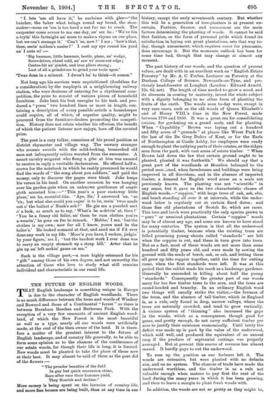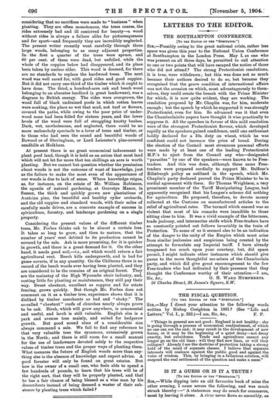" The prouder beauties of the field
In gay but quick succession shine, Race after race their honours yield, They flourish and decline."
More money is being spent on the luxuries of country life. and more fine houses are being built, than at any time in our
history, except the early seventeenth century. But whether this will be a generation of tree-planters is at present un- certain. Fashion, finance, and amusement are the main factors determining the planting of woods. It cannot be said that fashion, or the form of personal pride which found its satisfaction in laying out great plantations, sets that way to- day, though amusement, which requires cover for pheasants, does encourage it. But the economic outlook has been for some time bad, though that may change at almost any moment.
The past history of our woods, and the question of present values, are dealt with in an excellent work on "English Estate Forestry" by Mr. A. C. Forbes, Lecturer on Forestry at the Durham College of Science, Newcastle-on-Tyne, and pre- viously head-forester at Longleat (London : Edward Arnold, 12s. 6d. net). The length of time needed to grow a wood, and its slowness in coming to maturity, invest the whole subject with a dignity belonging to no other form of planting the fruits of the earth. The woods seen to-day were, except in very rare cases, such as the old woods of Queen Elizabeth's and of Henry Via's time in the New Forest, made between 1780 and 1850. It was a great era for consolidating estates, for gardening on a grand scale, and for planting. When " Capability " Brown was laying out a hundred and fifty acres of " grounds " at places like Wrest Park for the last of the De Grey Dukes of Bent, or for the Earls of Northampton at Castle Ashby, his employers were ready enough to plant the outlying parts of their estates, or the ridges seen from the park, with vast areas of estate timber. "When Brown laid down the law that certain ground ought to be planted, planted it was forthwith." We should say that a great part of the woodlands at Beaulieu belonged to the period menLoned, when farmhouses and buildings were being improved in all directions, and in the absence of imported timber, a demand for English wood arose on a scale not previously known. The planting was not "scientific" in any sense, but it gave us the two characteristic classes of English woods,—" coppice," with large trees of oak, ash, elm, and beech standing all over it at intervals, while the under- wood below is regularly cut at certain fixed dates ; and those fine old plantations of Scotch fir, which are rarer. This tree and larch were practically the only species grown in " pure " or unmixed plantations. Certain " coppice " woods may be of almost any age, and some are known to have stood for many centuries. The system is that all the underwood is potentially timber, because when the existing trees are felled promising young shoots called " standards " are left when the coppice is cut, and these in turn grow into trees. But as a fact, most of these woods are not more than some hundred and fifty years old, and were made by sowing the ground with the seeds of beech, oak, or ash, and letting them all grow up into coppice together, until the time for cutting came, when the first standards were left. It was at this period that the rabbit made his mark as a landscape gardener. Generally he succeeded in killing about half the young "standards." Consequently the greater part of our woods carry far too few timber trees to the acre, and the trees are round-headed and branchy. In an ordinary English wood two things will usually strike the visitor,—the fewness of the trees, and the absence of tall timber, which in England is, as a rule, only found in deep, narrow valleys, where the trees are naturally crowded, and tend to grow vertically. A vicious system of " thinning " also increased the gaps in the woods, which as a consequence, though good for game, and pretty enough, do not carry sufficient timber per acre to justify their existence economically. Until lately the deficit was made up in part by the value of the underwood, which sold well, and produced the equivalent of an annual crop if the produce of septennial cuttings was properly averaged. But at present this source of revenue has almost ceased. It hardly pays to cut the underwood.
To sum up the position as our forbears left it. The woods are extensive, but were planted with no definite aim, and on no system. The chances of trade have made the underwood worthless, and the timber is as a rule not valuable enough when mature to pay first the rent of the land during the many years in which it has been growing, and then to leave a margin to plant fresh woods with.
In addition, the woods are not so pretty as they might be, considering that no sacrifices were made to " business " when planting. They are often monotonous, the trees coarse, the rides extremely bad and ill contrived for beauty—a wood without rides is always a failure alike for picturesqueness and for sport—and frequently they are incredibly neglected. The present writer recently went carefully through three large woods, belonging to as many adjacent properties. In the first a quarter of the trees were spruce, and 60 per cent, of these were dead, but unfelled, while the whole of the coppice below had disappeared, and its place been taken by useless elder. This wood is doomed, for there are no standards to replace the hardwood trees. The next wood was well cared for, with good rides and good coppice. But it did not carry one-third of the timber which it ought to have done. The third, a hundred-acre oak and beech wood belonging to an absentee landlord (a great landowner), was a disgrace to British energy. The rides were overgrown, the wood full of black undrained pools in which rotten leaves were soaking, the place so wet that mud, not turf or flowers, covered the paths, while owing to the poor price of under- wood none had been felled for sixteen years, and the lower levels of the wood were full of straggling knotty bushes. Dark, wet, unwholesome, and neglected, there could be no more melancholy spectacle to a lover of trees and timber, or to those who had seen the sound and beautiful woods of Bowood or of Sheringham, or Lord Leicester's pine-covered sandhills at Holkham.
At present there is no great economical inducement to plant good land, though it is held as an axiom that most land which will not let for more that ten shillings an acre is worth planting. But we cannot but question whether the pessimism about woods is not the outcome of want of knowledge, just as the failure to make the most even of the appearance of our woods is due to lack of sense. Where knowledge reigns, as, for instance, on the estate of Mr. William Robinson, the apostle of natural gardening, at Gravetye Manor, in Sussex, the thick and quickly grown new plantations of Anglian pine, the beautiful and healthy cyder orchards, and the old coppice and standard woods, with their miles of carefully made drives, are a concrete example of success in sylviculture, forestry, and landscape gardening on a single property.
Considering the present values of the different timber trees, Mr. Forbes thinks oak to be almost a certain loss. It takes so long to grow, and then to mature, that the number of years' rent debited to its production cannot be covered by the sale. Ash is more promising, for it is quicker in growth, and there is a great demand for it. On the other band, it needs good soil,—i.e., soil which would return a fair agricultural rent. Beech kills undergrowth, and is bad for game coverts, if in any quantity. On the Chilterns there is no record of the beech woods ever having been planted, and they are considered to be the remains of an original forest. They are the mainstay of the High Wycombe chair industry, and, costing little for planting or maintenance, they still pay their way. Sweet chestnut, excellent as coppice and for estate fencing, grows quickly. But though Mr. Forbes does not comment on it as a timber tree, experience shows that it is disliked by timber merchants as bad and "shaky." The so-called "chestnut" roofs of churches nearly always prove to he oak. Birch, which will grow anywhere, is ornamental and useful, and larch is still valuable. English elm is a park and avenue tree mainly, and suited for hedgerow growth. But good sound elms of a considerable size always command a sale. We fail to find any reference to that very valuable tree the sycamore, extensively grown in the North; and there is still room for a small manual for the use of landowners devoted solely to the respective values of timber trees and the proper ways of planting them. What menaces the future of English woods more than any- thing else is the absence of knowledge and expert advice. A good forester will only be found on great estates. But how is the owner of a small one, who feels able to spend a few hundreds of pounds, to learn that his trees will be of the right sort, that they will be properly planted, and that he has a fair chance of being blessed as a wise man by his descendants instead of being deemed a waster of their sub- stance by planting trees which failed ?



























































 Previous page
Previous page